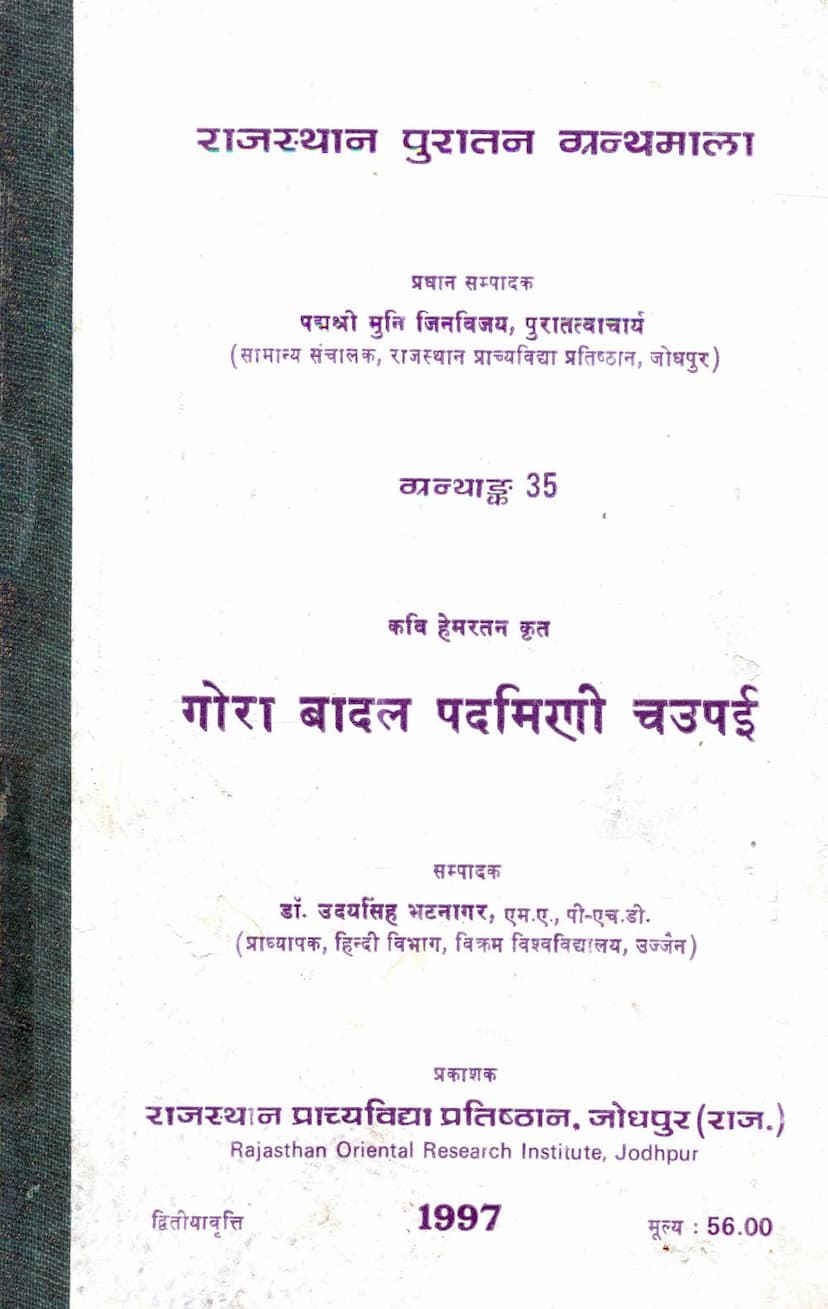Gora Badal Padmini Chaupai
Added to library: September 1, 2025

Summary
This is a comprehensive summary of the Jain text "Gora Badal Padmini Chaupai" by Hemratna Kavi, edited by Dr. Udaysinh Bhatnagar and published by Rajasthan Oriental Research Institute.
Title: Gora Badal Padmini Chaupai Author: Hemratna Kavi Editor: Dr. Udaysinh Bhatnagar Publisher: Rajasthan Oriental Research Institute Series: Rajasthan Puratan Granthamala, Granthank 35 Edition: Second Edition, 1997 (First Edition, 1966)
Overview:
"Gora Badal Padmini Chaupai" is a Jain poetic narrative that recounts the famous story of Padmini and the bravery of Gora and Badal. While Padmini's tale is widely known through Jayasi's "Padmavat," this work is presented as one of the earliest available Rajasthani language renditions of this historical episode. The text highlights the courage, loyalty, and strategic prowess of Gora and Badal in defending their kingdom and honor.
Key Themes and Content:
-
The Narrative of Padmini: The story centers around Queen Padmini, renowned for her beauty and virtue. The narrative delves into the events leading to the conflict with Alauddin Khilji, the ruler of Delhi.
-
The Role of Gora and Badal: Gora and Badal are portrayed as valiant warriors and loyal chieftains. They are the central figures in enacting a strategy to outwit Alauddin Khilji and protect Padmini and Chittor.
-
The Plot:
- Ratan Sen's Infatuation and Padmini's Capture: The story begins with the Raja of Chittor, Ratan Sen, bringing Padmini back from Singhaldeep after being enchanted by her beauty. During a period of separation, Ratan Sen's son, Veer Bhan, misunderstands Padmini's role in his father's absence.
- Alauddin's Obsession and Deception: Alauddin Khilji hears of Padmini's beauty and desires her. He invades Chittor. After initial setbacks, Alauddin, through deception and the help of a traitor (Raghav Chetan), manages to capture Ratan Sen.
- Gora and Badal's Plan: To rescue Ratan Sen and thwart Alauddin's plan to capture Padmini, Gora and Badal devise a daring strategy. They disguise themselves and their soldiers as women, hidden within palanquins (dolis), to infiltrate Alauddin's camp.
- The Rescue: Gora and Badal successfully infiltrate the enemy camp, rescue Ratan Sen, and engage in a fierce battle. Gora, the elder and strategist, fights bravely and eventually falls in battle, while Badal leads the charge with immense valor.
- Sacrifice and Victory: Gora's sacrifice inspires the soldiers. Badal, with his prowess, defeats Alauddin's forces and ensures the safety of Ratan Sen and the kingdom. Gora's wife immolates herself (Sati) after his death.
-
Literary Style and Language:
- Language: The Chaupai is written in Middle Rajasthani, reflecting the linguistic characteristics of the region between the 16th and 17th centuries. The language shows influences of regional dialects, particularly Godwadi, and also incorporates elements of Jain literary traditions and Dingal style (a poetic style used in heroic poetry).
- Style: The narrative is presented in the Chaupai meter, which is suitable for storytelling. The language is rich in descriptive imagery, especially concerning battles, emotions, and the beauty of the characters and setting.
-
Editorial and Scholarly Contributions:
- The book is part of the "Rajasthan Puratan Granthamala," dedicated to publishing ancient Rajasthani literature.
- The editor, Dr. Udaysinh Bhatnagar, has conducted extensive research, including preparing a critical edition and studying the language of the work for his Ph.D.
- The introductory sections by Munishri Jinavijay (Director) and Dr. Udaysinh Bhatnagar (the editor) provide historical context, discuss the significance of the work, and detail the editorial process, including the comparison of various manuscripts. They emphasize Hemratna Kavi's contribution as likely the first Rajasthani poet to base a work on the Gora-Badal theme.
-
Historical Context: The preface notes the publication of this work in the context of its prior release by the department about three decades earlier (from the 1997 edition). The renewed publication is due to the demand from scholars and literature enthusiasts. The text's composition around the year 1645 (V.S.) places it during a period of significant historical events in Mewar, like the struggle of Maharana Pratap, which likely influenced the theme of valor and sacrifice.
-
Textual Analysis: Dr. Bhatnagar's preface and introduction extensively discuss the textual variations found in different manuscripts, the challenges of reconstructing the original text, and the methodologies used for its critical editing. He identifies Hemratna's work as foundational for later compositions on the same theme.
Significance:
- Literary Value: "Gora Badal Padmini Chaupai" is a significant work in Rajasthani literature, preserving a heroic tale in an accessible poetic form.
- Historical Interest: It offers insights into the martial traditions, social values, and literary practices of medieval Rajasthan.
- Jain Literature: As a work by a Jain poet, it reflects the integration of secular historical themes within Jain literary output, demonstrating the broad scope of Jain literary contributions.
In essence, the "Gora Badal Padmini Chaupai" is a compelling narrative of courage, loyalty, and strategic brilliance, presented in a historically and linguistically important Rajasthani text, meticulously edited for scholarly and public appreciation.